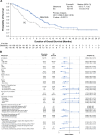Phase 3 study of gilteritinib versus salvage chemotherapy in predominantly Asian patients with relapsed/refractory FLT3-mutated acute myeloid leukemia
- PMID: 39237634
- PMCID: PMC11518977
- DOI: 10.1038/s41375-024-02382-9
Phase 3 study of gilteritinib versus salvage chemotherapy in predominantly Asian patients with relapsed/refractory FLT3-mutated acute myeloid leukemia
Abstract
The phase 3 COMMODORE trial evaluated gilteritinib versus salvage chemotherapy (SC) in a predominantly Asian relapsed/refractory (R/R) FLT3-mutated (FLT3mut+) acute myeloid leukemia (AML) patient population. The primary endpoint was overall survival (OS); secondary endpoints included event-free survival (EFS) and complete remission (CR) rate. As of June 30, 2020 (interim analysis: 32.2 months after study initiation), 234 patients were randomized (gilteritinib, n = 116; SC, n = 118). Median OS was significantly longer with gilteritinib versus SC (9.6 vs. 5.0 months; HR 0.566 [95% CI: 0.392, 0.818]; p = 0.00211) with a median follow-up of 10.3 months. Median EFS was also significantly longer with gilteritinib (2.8 vs. 0.6 months; HR 0.551 [95% CI: 0.395, 0.769]; p = 0.00004). CR rates with gilteritinib and SC were 16.4% and 10.2%, respectively; composite CR rates were 50.0% and 20.3%, respectively. Exposure-adjusted grade ≥3 adverse event (AE) rates were lower with gilteritinib (58.38 events/patient-year [E/PY]) versus SC (168.30 E/PY). Common AEs with gilteritinib were anemia (77.9%) and thrombocytopenia (45.1%). Gilteritinib plasma concentration peaked ~4 h postdose; ~3-fold accumulation occurred with multiple dosing. The COMMODORE trial demonstrated that gilteritinib significantly improved OS and EFS in predominantly Asian patients, validating the outcomes of gilteritinib from the ADMIRAL trial in R/R FLT3mut+ AML.
© 2024. The Author(s).
Conflict of interest statement
MY, TS, TK, MT, MK, XM, and NH are all employees of Astellas. TS reports Astellas stocks. BJ, JL, LL, XD, HJ, LG, JT, LWLL, AK, and EM report consulting and honoraria fees from Astellas. JW, JH, and SB have nothing to disclose.
Figures



Similar articles
-
Gilteritinib versus salvage chemotherapy in predominantly Asian patients with relapsed/refractory FLT3-mutated acute myeloid leukemia: a regional analysis of COMMODORE in China, South-East Asia, and Russia.Ann Hematol. 2025 Mar;104(3):1563-1575. doi: 10.1007/s00277-025-06235-y. Epub 2025 Mar 10. Ann Hematol. 2025. PMID: 40063243 Free PMC article. Clinical Trial.
-
Gilteritinib or Chemotherapy for Relapsed or Refractory FLT3-Mutated AML.N Engl J Med. 2019 Oct 31;381(18):1728-1740. doi: 10.1056/NEJMoa1902688. N Engl J Med. 2019. PMID: 31665578 Clinical Trial.
-
The impact of FLT3 mutation clearance and treatment response after gilteritinib therapy on overall survival in patients with FLT3 mutation-positive relapsed/refractory acute myeloid leukemia.Cancer Med. 2021 Feb;10(3):797-805. doi: 10.1002/cam4.3652. Epub 2020 Dec 19. Cancer Med. 2021. PMID: 33340276 Free PMC article.
-
The European Medicines Agency Review of Gilteritinib (Xospata) for the Treatment of Adult Patients with Relapsed or Refractory Acute Myeloid Leukemia with an FLT3 Mutation.Oncologist. 2020 Jul;25(7):e1070-e1076. doi: 10.1634/theoncologist.2019-0976. Epub 2020 Mar 10. Oncologist. 2020. PMID: 32154636 Free PMC article. Review.
-
ASP2215 in the treatment of relapsed/refractory acute myeloid leukemia with FLT3 mutation: background and design of the ADMIRAL trial.Future Oncol. 2018 Aug;14(20):1995-2004. doi: 10.2217/fon-2017-0582. Epub 2018 Mar 2. Future Oncol. 2018. PMID: 29498296 Review.
Cited by
-
Gilteritinib versus salvage chemotherapy in predominantly Asian patients with relapsed/refractory FLT3-mutated acute myeloid leukemia: a regional analysis of COMMODORE in China, South-East Asia, and Russia.Ann Hematol. 2025 Mar;104(3):1563-1575. doi: 10.1007/s00277-025-06235-y. Epub 2025 Mar 10. Ann Hematol. 2025. PMID: 40063243 Free PMC article. Clinical Trial.
-
Next-generation sequencing for guiding matched targeted therapies in people with relapsed or metastatic cancer.Cochrane Database Syst Rev. 2025 Mar 24;3(3):CD014872. doi: 10.1002/14651858.CD014872.pub2. Cochrane Database Syst Rev. 2025. PMID: 40122129
References
-
- Chevallier P, Labopin M, Turlure P, Prebet T, Pigneux A, Hunault M, et al. A new Leukemia Prognostic Scoring System for refractory/relapsed adult acute myelogeneous leukaemia patients: a GOELAMS study. Leukemia. 2011;25:939–44. - PubMed
-
- Moreno I, Martin G, Bolufer P, Barragan E, Rueda E, Roman J, et al. Incidence and prognostic value of FLT3 internal tandem duplication and D835 mutations in acute myeloid leukemia. Haematologica. 2003;88:19–24. - PubMed
-
- Gale RE, Green C, Allen C, Mead AJ, Burnett AK, Hills RK, et al. The impact of FLT3 internal tandem duplication mutant level, number, size, and interaction with NPM1 mutations in a large cohort of young adult patients with acute myeloid leukemia. Blood. 2008;111:2776–84. - PubMed
Publication types
MeSH terms
Substances
Grants and funding
LinkOut - more resources
Full Text Sources
Medical
Research Materials
Miscellaneous

